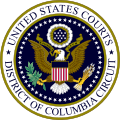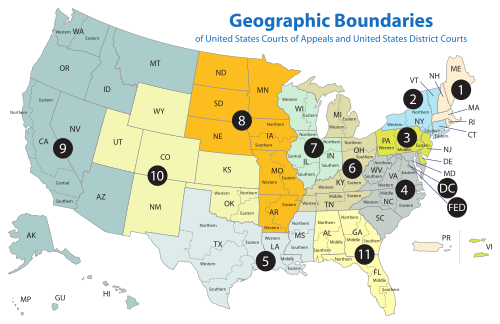|
United States Court of Appeals for the District of Columbia Circuit
The United States Court of Appeals for the District of Columbia Circuit (in case citations, D.C. Cir.) is one of the thirteen United States Courts of Appeals. It has the smallest geographical jurisdiction of any of the U.S. courts of appeals, and it covers only the U.S. District Court for the District of Columbia.[a] It meets at the E. Barrett Prettyman United States Courthouse in Washington, DC. The D.C. Circuit is often considered to be second only to the U.S. Supreme Court in status and prestige, and it is sometimes unofficially termed "the second highest court in the land".[2] Because its jurisdiction covers the District of Columbia, it tends to be the main federal appellate court for issues of U.S. administrative law and constitutional law.[2] Four of the nine current Supreme Court justices were previously judges on the D.C. Circuit: Chief Justice John Roberts and associate justices Clarence Thomas, Brett Kavanaugh, and Ketanji Brown Jackson. Past justices Ruth Bader Ginsburg, Antonin Scalia, Warren E. Burger, Fred M. Vinson, and Wiley Blount Rutledge also served on the D.C. Circuit before their appointments to the Supreme Court. Because the D.C. Circuit does not represent any state, confirmation of nominees can be procedurally and practically easier than for nominees to the Courts of Appeals for the other geographical districts, as home-state senators have historically been able to hold up confirmation through the blue slip process. Current composition of the courtAs of January 16, 2024[update]:
List of former judges
Chiefs
When Congress established this court in 1893 as the Court of Appeals of the District of Columbia, it had a chief justice, and the other judges were called associate justices, which was similar to the structure of the Supreme Court. The chief justiceship was a separate seat: the president would appoint the chief justice, and that person would stay chief justice until he left the court.[citation needed] On June 25, 1948, 62 Stat. 869 and 62 Stat. 985 became law. These acts made the chief justice a chief judge. In 1954, another law, 68 Stat. 1245, clarified what was implicit in those laws: that the chief judgeship was not a mere renaming of the position but a change in its status that made it the same as the chief judge of other inferior courts.[citation needed] Chief judges have administrative responsibilities with respect to their circuits, and preside over any panel on which they serve, unless the circuit justice (the Supreme Court justice responsible for the circuit) is also on the panel. Unlike the Supreme Court, where one justice is specifically nominated to be chief, the office of chief judge rotates among the circuit judges. To be chief, a judge must have been in active service on the court for at least one year, be under the age of 65, and have not previously served as chief judge. A vacancy is filled by the judge highest in seniority among the group of qualified judges, with seniority determined first by commission date, then by age. The chief judge serves for a term of seven years, or until age 70, whichever occurs first. If no judge qualifies to be chief, the youngest judge over the age of 65 who has served on the court for at least one year shall act as chief until another judge qualifies. If no judge has served on the court for more than a year, the most senior judge shall act as chief. Judges can forfeit or resign their chief judgeship or acting chief judgeship while retaining their active status as a circuit judge.[3] When the office was created in 1948, the chief judge was the longest-serving judge who had not elected to retire, on what has since 1958 been known as senior status, or declined to serve as chief judge. After August 6, 1959, judges could not become or remain chief after turning 70 years old. The current rules have been in operation since October 1, 1982.[4]
Succession of seatsThe court has eleven seats for active judges after the elimination of Seat 8 under the Court Security Improvement Act of 2007. The seat that was originally the chief justiceship is numbered as Seat 1; the other seats are numbered in order of their creation. If seats were established simultaneously, they are numbered in the order in which they were filled. Judges who retire into senior status remain on the bench but leave their seat vacant. That seat is filled by the next circuit judge appointed by the president.
See also
Notes
References
External linksWikisource has original works on the topic: United States Court of Appeals for the District of Columbia Circuit
|
||||||||||||||||||||||||||||||||||||||||||||||||||||||||||||||||||||||||||||||||||||||||||||||||||||||||||||||||||||||||||||||||||||||||||||||||||||||||||||||||||||||||||||||||||||||||||||||||||||||||||||||||||||||||||||||||||||||||||||||||||||||||||||||||||||||||||||||||||||||||||||||||||||||||||||||||||||||||||||||||||||||||||||||||||||||||||||||||||||||||||||||||||||||||||||||||||||||||||||||||||||||||||||||||||||||||||||||||||||||||||||||||||||||||||||||||||||||||||||||||||||||||||||||||||||||||||||||||||||||||||||||||||||||||||||||||||||||||||||||||||||||||||||||||||||||||||||||||||||||||||||||||||||||||||||||||||||||||||||||||||||||||||||||||||||||||||||||||||||||||||||||||||||||||||||||||||||||||||||||||||||||||||||||||||||||||||||||||||||||||||||||||||||||||||||||||||||||||||||||||||||||||||||||||||||||||||||||||||||||||||||||||||||||||||||||||||||||||||||||||||||||||||||||||||||||||||||||||||||||||||||||||||||||||||||||||||||||||||||||||||||||||||||||||||||||||||||||||||
Portal di Ensiklopedia Dunia


